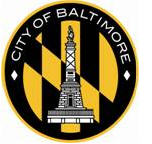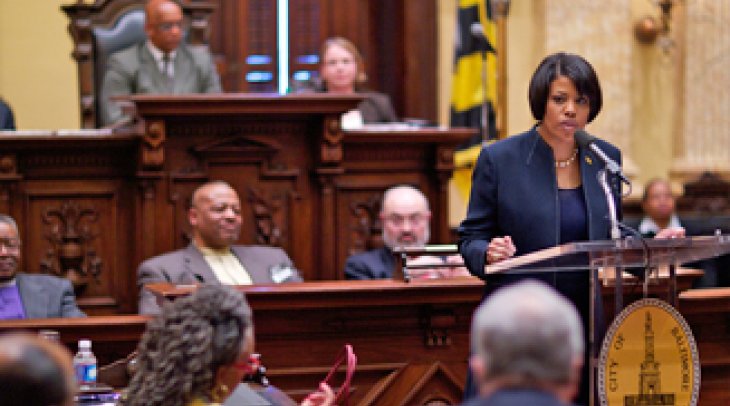Mayor Rawlings-Blake Delivers State of the City Address
Monday Feb 13th, 2012

FOR IMMEDIATE RELEASE

Today, Mayor Stephanie Rawlings-Blake delivered the State of the City Address as newly-elected Mayor of Baltimore. Mayor Rawlings-Blake urged members of the City Council to fully support an ambitious goal to grow the city by 10,000 families over the next ten years by enacting new proposals to improve school buildings, reduce crime, and decrease property taxes for Baltimore’s families. The Mayor offered a preview of several new initiatives that she will propose to the City Council in the budget, which improves public safety, education, neighborhood revitalization, and economic development.
“We should build these pillars of growth by focusing on them with renewed vigor, by investing in them with our scarce resources, and by saying no to other things that may make us feel good but are not as important to the cause,” said Mayor Rawlings-Blake. “We need to get Baltimore growing again, and this is our time to lead.”
The Mayor believes her ambitious goal to grow the city by 10,000 families over the next ten years can be achieved by building on what she calls the “Pillars of Growth”: improved public education, further reducing the crime rate, rebuilding communities with vacant properties, and providing property tax relief for homeowners. Mayor Rawlings-Blake called on members of the City Council to support a forthcoming resolution that supports her goal of growing the city by 10,000 families in 10 years. The resolution will be introduced by newly-elected Councilman Nick Mosby.
Two Years of Progress
The Mayor highlighted progress and success already achieved in these Pillars of Growth in her first two full years in office. Baltimore’s homicide rate reached the lowest in over 30 years, plunging another 17% in two years. Overall violent crime has dropped 7%, and juvenile crime declined 37% in the same time period. The decline in violent crime represents 679 fewer victims of violence in 2011, compared to 2009.
“It is not time to celebrate, but it is also not a time for cynicism,” said Mayor Rawlings-Blake. “It is time to acknowledge that Baltimore is becoming safer for families. It is time to believe in a safer city and to work even harder because we know the progress is real.”
The Mayor also acknowledged the efforts of Baltimore City Public Schools to improve educational opportunities for students. With more choices for students and families, the dropout rate has been halved since 2007. The graduation rate increased in 2010-11, and was the largest year-over-year increase in a decade.
Under the Mayor’s Vacants to Value program, the City has demolished more than 400 vacant homes, issued 687 code violation citations on blighted properties, leveraged more than $37 million in new private investment, and has provided targeted incentives to new homebuyers of formerly-vacant houses. Mayor Rawlings-Blake introduced Vernon Brown, and Arthur Grace and Jessica Martin, who purchased previously-vacant homes in the city with the help of Vacants to Value incentives.
“We accomplished all of this, even in the darkest of economic times,” added Mayor Rawlings-Blake. “At the same time that we cut more than $120 million from the budget, we made smart investments by fully-funding our contribution to public schools and neighborhood libraries, continuing an aggressive plan to hire hundreds of new police officers, and by investing in neighborhood street repair—all without raising any property taxes. During these two very difficult budget years, we maintained our City’s bond rating, replenished our rainy-day fund, implemented a smarter budget process, and started a 10-year financial plan for the future.”
Growing Neighborhoods
Mayor Rawlings-Blake announced legislation to reduce the effective property tax rate for homeowners by 20-cents by 2020. When implemented, it will be the largest cut in property taxes in recent history. The Mayor urged the City Council to support this plan, which will target tax relief for current residents and new families investing in Baltimore’s neighborhoods. Under the proposal, an owner-occupied home in Baltimore assessed at $200,000 would see an annual tax reduction of $40 in 2013, growing to $400 by 2020. Owners of vacant homes, vacant lots, or blighted properties will not qualify for this tax cut.
“Rather than standing around and talking about what can’t be done, I need your support to pass this tax cut now, so that homeowners know the City is moving in the right direction, lowering their tax bills,” said Mayor Rawlings-Blake. “Let’s do this now and help get Baltimore growing again.”
The Mayor also announced the expansion of the Billing Integrity Program, which was started by her administration in 2010. To date, the program identified properties wrongly receiving the Homestead Tax Credit, which represents millions of dollars in previously lost revenue. The new funding will support additional auditors to research and identify individuals receiving tax credits in error.
Investing in the Future
Mayor Rawlings-Blake announced that her budget for the Fiscal Year 2013 will fully fund the City’s commitment to public schools, despite a third straight year of budget deficits. The Mayor urged members of the City Council to support the Better Schools Initiative, which proposes to increase the City’s contribution to school construction by 140%—the largest increase in modern times. The Better Schools Initiative could inject $300 million in bond proceeds into city school construction and renovation with dedicated revenues from the beverage container tax.
“It is wrong to pretend that we can make a real dent in this problem without new funding. It’s false to say we can borrow a billion dollars but that we won’t have to pay it back one way or another. And it isn’t honest to say there won’t be sacrifice,” said Mayor Rawlings-Blake. “The special interests and lobbyists will tell you there’s another way—but they won’t tell you how. It’s a new tax, and its one we need to pass now to invest in our kids and our future. Pass this bill. Help our students and get Baltimore growing again.”
Mayor Rawlings-Blake also urged Councilmembers and the greater community to support the school system in making the vast inventory of current school buildings more efficient. The school system has been working on a much-anticipated facility assessment to address the serious problem of underutilization.
“Some schools will expand; some schools will merge; and some schools that we may have fond memories of will need to close,” said Mayor Rawlings-Blake. “Nostalgia has the power to make the past a priority over the present. We might not always like what is proposed, but all of us should support the work of the School Board on this mission—it’s what’s best for our kids, our future, and it will help get Baltimore growing again.”
A Safer City
Mayor Rawlings-Blake announced plans to continue recruiting and training new police officers so the Police Department is adequately staffed in every district. New officers will contribute to an increased presence of foot-patrols in targeted neighborhoods and commercial corridors.
“We are going to invest in the progress we’ve made reducing crime and violence, and we won’t stop until Baltimore is the safest big city in the country,” Mayor Rawlings-Blake said. “We all understand that a safer city is a growing city, and so public safety must remain our top priority.
Police Officers will be assisted by additional investment in crime-fighting technology, including the City’s cost-effective crime camera network. This year, the City will add thirty new cameras in the Belair Edison and Coldstream-Homestead-Montebello communities. The Mayor also pledged to partner with community and business groups to add cameras on major city thoroughfares.
The Mayor thanked Police Commissioner Frederick Bealefeld for new directors to improve officer training and increase accountability with the public. Chief John King, a former Deputy Chief from the Montgomery County Police, will serve as the new Director of Education and Training. Chief Grayland Williams, a former Federal DEA officer, will serve as head of the Department’s Internal Affairs Division.
“The trust between the people and their government—especially the police—is sacred,” added Mayor Rawlings-Blake. “It is worth every effort to build trust between our officers and the people they serve.”
New Partnerships
Mayor Rawlings-Blake outlined new investments to help the city’s centers of economic growth. This year, the City is funding a $20 road construction project on Broening Highway and Newkirk Avenue. This will support the State’s plans to expand capacity at the Port of Baltimore. The City is also in the process of rewriting decades-old zoning code to allow for future development along the waterfront as the city’s maritime industries expand.
Mayor Rawlings-Blake touted unprecedented partnerships with the City’s health care, education, and research institutions to promote new investment, including working with the University of Maryland Baltimore to transform Baltimore’s Westside. The Mayor also announced the proposed extension of the Charm City Circulator’s Purple Line up to 33rd Street. This will connect Johns Hopkins University, as well as residents of the Old Goucher and Charles North communities, with Penn Station, and support future growth in the center of the city.
Mayor Rawlings-Blake said this year’s budget will create new community job hubs in areas with high unemployment and poverty, fully fund the City’s one-stop career centers, and add year-round job opportunities for young people.
“Despite a tough budget, we are going to fully fund our Neighborhood Main Streets program to support growing small businesses. And we a going to work with them to keep our neighborhood retail districts clean by investing in a small fleet of new Madvac street sweepers,” Mayor Rawlings-Blake said.
Mayor Rawlings-Blake thanked the many people who contributed their own ideas for growing the City by 10,000 families in 10 years. She believes it reflects residents’ and business leaders’ deep commitment to Baltimore. She named some of the ideas, including forging a partnership with the International Rescue Committee to bring political refugees and new immigrants to Baltimore, and developing a Green Infrastructure Bank to provide credits to developments and businesses who clean up vacant lots in city neighborhoods.
“The truth is, when you cut through all the loud cynicism, there are hundreds of thousands of quiet families who want nothing more than to lift-up our neighborhoods and grow our city,” added Mayor Rawlings-Blake. “We need to harness this creativity.”
The Mayor announced that the city would soon launch a new “crowdsourcing” website to channel new ideas from the public. City employees and agency heads will be trained to use the new interactive tool, so they can work with the public to put good ideas in place in our agencies, and make the government more efficient and responsive.